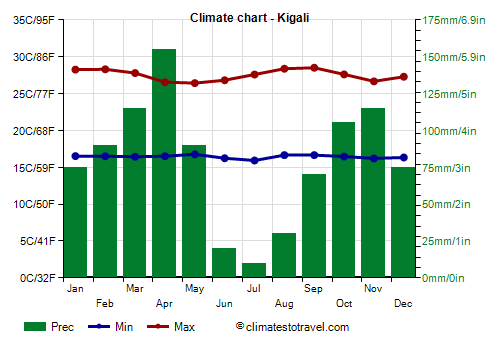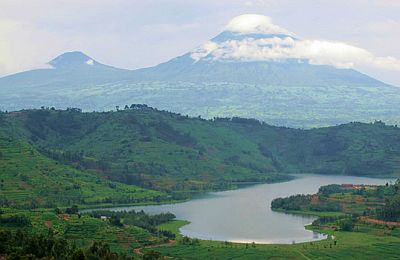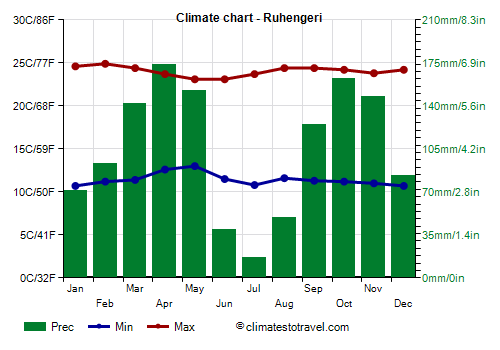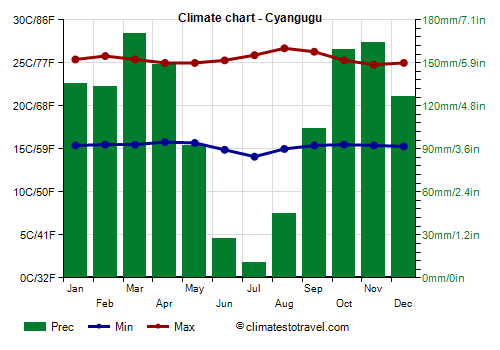Select units of measurement for the temperature and rainfall tables (metric or imperial).
Average weather, temperature, rainfall, sunshine
In Rwanda, the "land of a thousand hills", located just south of the Equator, there is a
tropical highland climate, pleasantly warm all year round.
In fact, most of the country is located on a
plateau, around 1,500 meters (5,000 feet) above sea level. The altitude decreases below a thousand meters (3,300 feet) only in the westernmost part, along the Rusizi River, which marks the border with the Democratic Republic of the Congo, and which is therefore the only area where it can get hot, and the temperature can sometimes reach 35 °C (95 °F).
The
rains are quite abundant, and range from 1,000 to 1,400 millimeters (40 to 55 inches) per year depending on area.
There is a
dry season from June to August (with July as the driest month) and a
rainy season from September to May. On closer view, there would be two rainy seasons, caused by the zenith passages of the sun, from March to May and from September to November. However, the decrease in rainfall from December to February is small, and it's just more pronounced in the north, where it drops below 100 mm (4 in) per month, so we cannot properly speak of dry season. Between the two rainy seasons, the most intense is the one going from March to May, and the rainiest months are usually April and May, when precipitation reaches 150 mm (6 in) per month, or even more.
The rains in Rwanda usually occur in the form of downpours or thunderstorms, but there is not much
sun, in fact, the sky is often cloudy, although in the driest months, especially in June and July, the sun comes out more often.
The climate in detail
Hills and mountains
Kigali

The capital,
Kigali, is located at the center of the country, at 1,500 meters (5,000 feet) above sea level. Temperatures are stable all year round, and hover around 26/28 °C (80/82 °F) during the day and around 16/17 °C (61/62 °F) at night.
Kigali receives 950 mm (37.5 in) of rain per year, with a maximum in April and a minimum from June to August, when it almost never rains. From December to February, the rains are still quite frequent.

In the east, the Akagera National Park is located around 1,300/1,400 meters (4,200/4,600 feet) above sea level. In the west, Lake Kivu is at 1,450 meters (4,757 feet).
In the cities located
at higher altitudes (see Nyanza, Butare, Ruhengeri), the temperatures are a bit lower, and at night it's cool, if not a bit cold.
Ruhengeri

In
Ruhengeri (or Musanze), located in the north, 1,800 meters (5,900 feet) above sea level, near the Volcanoes National Park, the maximum temperatures fluctuate between 23 and 25 °C (73 and 77 °F) throughout the year.
Here, 1,200 mm (50 in) of rain fall per year, with a similar trend to that of Kigali (a more pronounced dry season from June to August and a less pronounced one from December to February).
Cyangugu

In the
south, the decrease in rainfall from December to February is felt even less, so much so that there is only one rainy season from September to May, as you can see from the rainfall in
Cyangugu, on the southern shores of Lake Kivu. Here, 1,300 mm (51 in) of rain fall per year.
High altitude
In Rwanda, there are also
high mountains, in particular, in the north we find the
Virunga Mountains, a volcanic chain whose highest peak is Mount Karisimbi, 4,507 meters (14,787 feet) high, located in the
Volcanoes National Park.
Along the mountain slopes, the sky is often covered with clouds. At middle-low altitudes, a cloud forest grows, while above 3,000 meters (9,800 ft), the climate is colder, the vegetation is sparser and the forest is replaced by shrubs, and the temperature at night can drop below freezing (0 °C or 32 °F). Finally, at high altitude, we find a cold desert.
South of the Virunga Mountains, the whole western part of the country is mountainous: in the west, in the Murambi province, the highest peaks reach 2,700 meters (8,900 ft), while in the south-west, in the Nyungwe Forest National Park, they reach 2,500 meters (8,200 ft).
Above 2,000 meters (6,500 feet), it can get cold at night throughout the year.
In mountainous areas, rainfall is more abundant, and showers can occur throughout the year.

When to go
The best time to visit Rwanda runs from
June to August, since it is the driest of the year. June and July are the best months, while by the second half of August, the rains usually start to get a bit more frequent.
A jacket or sweater is recommended for the evening and for mountain excursions, while for the high mountains it is necessary to cover more heavily.
What to pack
In winter (June to August): bring spring/autumn clothes (light for the day), a sweater and a jacket for the evening, a sun hat, and hiking shoes. For the Virunga Mountains, bring warm clothes, such as a down jacket, a hat, and gloves.
In the rest of the year: bring spring/autumn clothes (light for the day), a sweatshirt, a raincoat, hiking shoes, and a light jacket for the evening above 1,500 meters (5,000 feet). For the Virunga Mountains, bring warm clothes, such as a down jacket, a hat, and gloves.
Climate data - Rwanda
|
| Cyangugu (1,500 meters) |
|---|
| Jan | Feb | Mar | Apr | May | Jun | Jul | Aug | Sep | Oct | Nov | Dec |
|---|
| Min temp. | 15 | 16 | 16 | 16 | 16 | 15 | 14 | 15 | 15 | 16 | 15 | 15 |
|---|
| Max temp. | 25 | 26 | 25 | 25 | 25 | 25 | 26 | 27 | 26 | 25 | 25 | 25 |
|---|
| Precip. | 135 | 135 | 170 | 150 | 90 | 30 | 10 | 45 | 105 | 160 | 165 | 125 |
|---|
| Prec. days | 19 | 16 | 20 | 20 | 15 | 5 | 2 | 6 | 14 | 22 | 22 | 21 |
|---|
|
|
| Kigali (1,500 meters) |
|---|
| Jan | Feb | Mar | Apr | May | Jun | Jul | Aug | Sep | Oct | Nov | Dec |
|---|
| Min temp. | 17 | 17 | 16 | 17 | 17 | 16 | 16 | 17 | 17 | 16 | 16 | 16 |
|---|
| Max temp. | 28 | 28 | 28 | 27 | 26 | 27 | 28 | 28 | 29 | 28 | 27 | 27 |
|---|
| Precip. | 75 | 90 | 115 | 155 | 90 | 20 | 10 | 30 | 70 | 105 | 115 | 75 |
|---|
| Prec. days | 11 | 11 | 15 | 18 | 13 | 2 | 1 | 4 | 10 | 17 | 17 | 14 |
|---|
| Sun hours | 5 | 6 | 5 | 4 | 4 | 6 | 6 | 5 | 5 | 5 | 4 | 4 |
|---|
|
| Ruhengeri (1,800 meters) |
|---|
| Jan | Feb | Mar | Apr | May | Jun | Jul | Aug | Sep | Oct | Nov | Dec |
|---|
| Min temp. | 11 | 11 | 11 | 13 | 13 | 12 | 11 | 12 | 11 | 11 | 11 | 11 |
|---|
| Max temp. | 25 | 25 | 24 | 24 | 23 | 23 | 24 | 24 | 24 | 24 | 24 | 24 |
|---|
| Precip. | 70 | 95 | 140 | 175 | 150 | 40 | 15 | 50 | 125 | 160 | 145 | 85 |
|---|
| Prec. days | 13 | 15 | 20 | 23 | 19 | 7 | 3 | 8 | 18 | 22 | 22 | 16 |
|---|
|
|